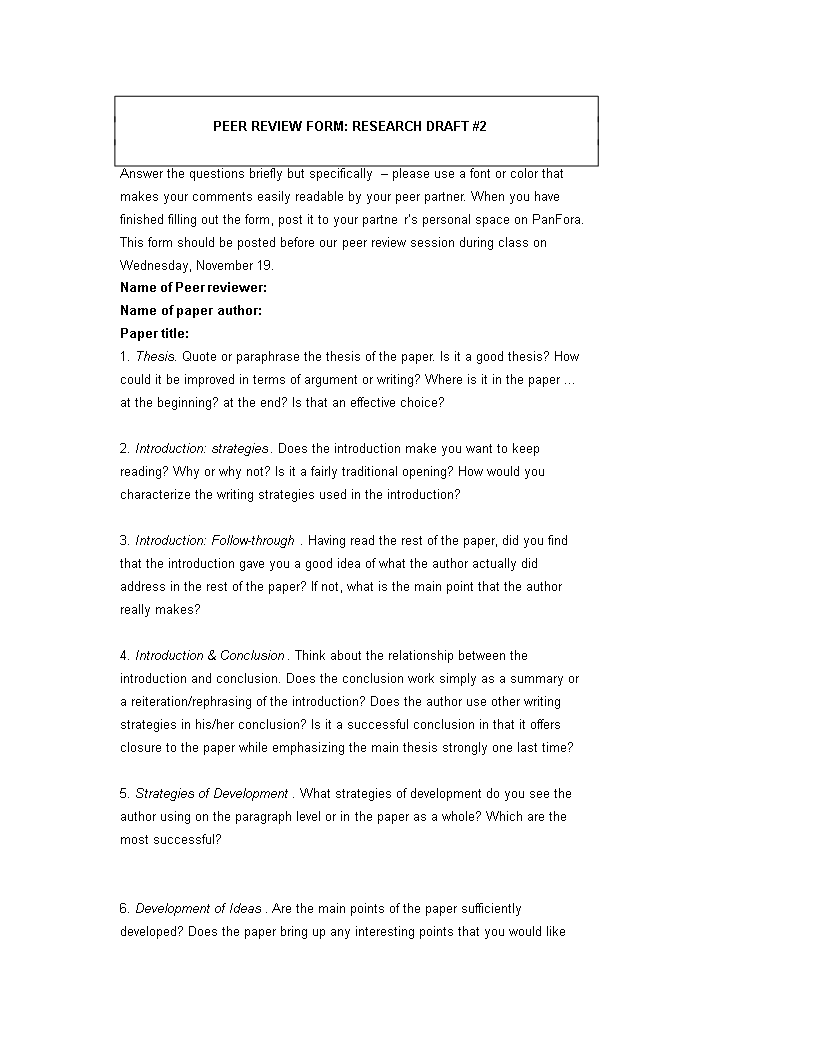Peer Review Form

Guardar, completar los espacios en blanco, imprimir, listo!
What is a peer review form? How can peer review be described? Learn more by reading our content below and downloading our sample template. Get this peer review template now!
Formatos de archivo disponibles:
.doc- Este documento ha sido certificado por un profesionall
- 100% personalizable
Business Negocio HR RH Author Autor Paper Papel There Ahí Use Utilizar Introduction Introducción Peer Improvement Forms Formas de mejora de pares
What is a peer review form? How can peer review be described? Learn more by reading our content below and downloading our sample template. Peer review is the process of having colleagues review each others' work. It is a valuable tool for ensuring quality and accuracy in a collaborative setting. It also fosters a culture of feedback and learning.
Peer Review Forms play a critical role in maintaining quality, accuracy, and fairness in various professional and academic processes. They are commonly used in the following contexts:
A Peer Review Form is a structured document or questionnaire used in various professional and academic contexts to evaluate and provide feedback on the work, performance, or contributions of one's peers. Peer review is a systematic process in which individuals with similar expertise or roles assess each other's work to ensure quality, accuracy, and alignment with specific criteria or standards. These forms are commonly used in fields such as academia, research, publishing, and project management, among others.
The specific content and format of a Peer Review Form can vary significantly based on the context and the type of work being reviewed. However, common components typically include the following:
- Title or Description: A brief title or description of the work or item being reviewed.
- Reviewer Information: Information about the person conducting the peer review, including their name, affiliation, and contact information.
- Author or Creator Information: Information about the person or team responsible for the work being reviewed, including their name(s) and affiliation(s).
- Review Criteria: A clear list of criteria or standards against which the work will be assessed. These criteria should be specific, measurable, and relevant to the purpose of the review.
- Rating Scale: A scale or set of checkboxes that allow the reviewer to assign ratings or scores to each criterion. Common rating scales include numerical ratings (e.g., 1 to 5) or descriptive categories (e.g., poor, fair, good, excellent).
- Comments and Justifications: Space for the reviewer to provide written comments, observations, or justifications for their ratings. This section is where detailed feedback is provided.
- Overall Assessment: A section where the reviewer can provide an overall assessment or summary of the work, including strengths, weaknesses, and any recommendations for improvement.
- Recommendation: If applicable, a section where the reviewer can recommend whether the work should be accepted, revised, or rejected.
- Reviewer's Signature: To confirm that the peer review was conducted by the reviewer.
- Date of Review: The date when the peer review was conducted.
- Academic Journals: Peer reviewers assess research papers submitted for publication, ensuring the validity and quality of the research.
- Grant Proposals: Reviewers evaluate grant applications to determine their merit and alignment with funding criteria.
- Peer Evaluation in Workplaces: In some workplaces, employees participate in peer evaluations to provide feedback on each other's performance and contributions.
- Group Projects and Collaborations: Team members may use peer review to assess each other's contributions to a project and allocate credit fairly.
- Manuscript Editing: Editors and proofreaders use peer review forms to evaluate and provide feedback on written documents, such as articles, reports, and manuscripts.
Peer Review Forms help maintain professional standards, support continuous improvement, and ensure that work meets specific quality and performance criteria. They are valuable tools for promoting accountability and collaboration among peers.
This Peer Review Form has ways to grab your reader’s attention. It is created by HR professionals, intelligently structured, and easy to navigate through. Pay close attention to the most downloaded HR templates that fit your needs.
Download this Human Resources Peer Review Form template now!
DESCARGO DE RESPONSABILIDAD
Nada en este sitio se considerará asesoramiento legal y no se establece una relación abogado-cliente.
Deja una respuesta. Si tiene preguntas o comentarios, puede colocarlos a continuación.
